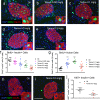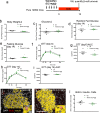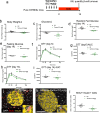Tamoxifen suppresses pancreatic β-cell proliferation in mice
- PMID: 31490929
- PMCID: PMC6731016
- DOI: 10.1371/journal.pone.0214829
Tamoxifen suppresses pancreatic β-cell proliferation in mice
Abstract
Tamoxifen is a mixed agonist/antagonist estrogen analogue that is frequently used to induce conditional gene deletion in mice using Cre-loxP mediated gene recombination. Tamoxifen is routinely employed in extremely high-doses relative to typical human doses to induce efficient gene deletion in mice. Although tamoxifen has been widely assumed to have no influence upon β-cells, the acute developmental and functional consequences of high-dose tamoxifen upon glucose homeostasis and adult β-cells are largely unknown. We tested if tamoxifen influences glucose homeostasis in male mice of various genetic backgrounds. We then carried out detailed histomorphometry studies of mouse pancreata. We also performed gene expression studies with islets of tamoxifen-treated mice and controls. Tamoxifen had modest effects upon glucose homeostasis of mixed genetic background (F1 B6129SF1/J) mice, with fasting hyperglycemia and improved glucose tolerance but without overt effects on fed glucose levels or insulin sensitivity. Tamoxifen inhibited proliferation of β-cells in a dose-dependent manner, with dramatic reductions in β-cell turnover at the highest dose (decreased by 66%). In sharp contrast, tamoxifen did not reduce proliferation of pancreatic acinar cells. β-cell proliferation was unchanged by tamoxifen in 129S2 mice but was reduced in C57Bl6 genetic background mice (decreased by 59%). Gene expression studies revealed suppression of RNA for cyclins D1 and D2 within islets of tamoxifen-treated mice. Tamoxifen has a cytostatic effect on β-cells, independent of changes in glucose homeostasis, in mixed genetic background and also in C57Bl6 mice. Tamoxifen should be used judiciously to inducibly inactivate genes in studies of glucose homeostasis.
Conflict of interest statement
JAK currently serves as medical director of McNair Interests, a private equity group with investments in type 1 diabetes and other chronic illnesses and is also an advisor for Sanofi and Lexicon. CJL declares no conflict of interest relevant to this article. MMR currently serves as a full time employee of Janssen Research and Development, Johnson and Johnson, Springhouse, PA. AG currently serves as a full time employee of the Novartis Institutes for BioMedical Research (NIBR), a subsidiary of Novartis International AG, Cambridge, MA. No other potential conflicts of interest relevant to this article were reported. This does not alter our adherence to PLOS ONE policies on sharing data and materials.
Figures






Similar articles
-
Effects of c-MYC activation on glucose stimulus-secretion coupling events in mouse pancreatic islets.Am J Physiol Endocrinol Metab. 2008 Jul;295(1):E92-102. doi: 10.1152/ajpendo.90235.2008. Epub 2008 Apr 15. Am J Physiol Endocrinol Metab. 2008. PMID: 18413670
-
GABA promotes β-cell proliferation, but does not overcome impaired glucose homeostasis associated with diet-induced obesity.FASEB J. 2019 Mar;33(3):3968-3984. doi: 10.1096/fj.201801397R. Epub 2018 Dec 3. FASEB J. 2019. PMID: 30509117
-
Glucose Induces Mouse β-Cell Proliferation via IRS2, MTOR, and Cyclin D2 but Not the Insulin Receptor.Diabetes. 2016 Apr;65(4):981-95. doi: 10.2337/db15-0529. Epub 2016 Jan 6. Diabetes. 2016. PMID: 26740601 Free PMC article.
-
Characterization of mice expressing Ins1 gene promoter driven CreERT recombinase for conditional gene deletion in pancreatic β-cells.Islets. 2014;6(1):e27685. doi: 10.4161/isl.27685. Islets. 2014. PMID: 25483876 Free PMC article.
-
Postnatal knockout of beta cell insulin receptor impaired insulin secretion in male mice exposed to high-fat diet stress.Mol Cell Endocrinol. 2020 Jan 1;499:110588. doi: 10.1016/j.mce.2019.110588. Epub 2019 Sep 18. Mol Cell Endocrinol. 2020. PMID: 31541682
Cited by
-
The role of AKR1 family in tamoxifen resistant invasive lobular breast cancer based on data mining.BMC Cancer. 2021 Dec 9;21(1):1321. doi: 10.1186/s12885-021-09040-8. BMC Cancer. 2021. PMID: 34886806 Free PMC article.
-
Pancreas-derived DPP4 is not essential for glucose homeostasis under metabolic stress.iScience. 2023 Apr 26;26(5):106748. doi: 10.1016/j.isci.2023.106748. eCollection 2023 May 19. iScience. 2023. PMID: 37216093 Free PMC article.
-
Cardioprotective effect of genetic ablation of the G-protein-coupled receptor kinase GRK2 in adult pancreatic β-cells during high-fat diet.J Biol Chem. 2025 Apr;301(4):108388. doi: 10.1016/j.jbc.2025.108388. Epub 2025 Mar 5. J Biol Chem. 2025. PMID: 40054692 Free PMC article.
-
Leucine Suppresses α-Cell cAMP and Glucagon Secretion via a Combination of Cell-Intrinsic and Islet Paracrine Signaling.Diabetes. 2024 Sep 1;73(9):1426-1439. doi: 10.2337/db23-1013. Diabetes. 2024. PMID: 38870025 Free PMC article.
-
Protective effects of cardamom aqueous extract against tamoxifen-induced pancreatic injury in female rats.Toxicol Res. 2023 Jun 27;39(4):721-737. doi: 10.1007/s43188-023-00198-w. eCollection 2023 Oct. Toxicol Res. 2023. PMID: 37779590 Free PMC article.
References
Publication types
MeSH terms
Substances
Grants and funding
LinkOut - more resources
Full Text Sources
Molecular Biology Databases

